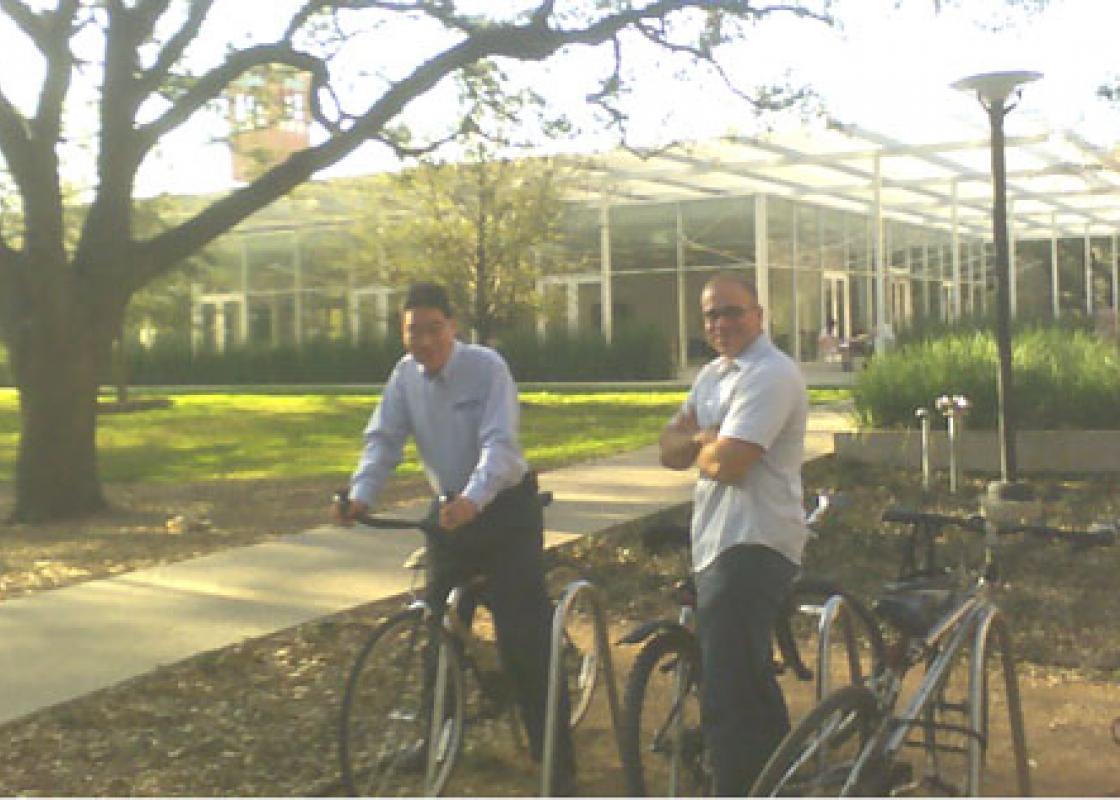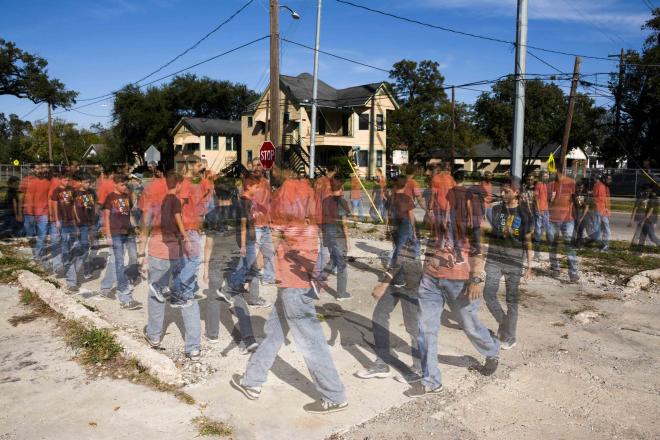Peter Wang is a Geophysicist, a League of American Bicyclists cycling instructor, and an advocate for cyclists in the Houston-Galveston region. On March 5th, sitting outside the Brochstein Pavilion, he discussed the state of bicycling with Colin Tangeman, a writer and teacher at the University of Houston, and Raj Mankad, editor of Cite.
Raj Mankad and Colin Tangeman: What is your vision for cycling in this area? What are the problems? What needs to happen?
Peter Wang: Do we mean Harris County or City of Houston, that’s an important distinction?
Dan Raine is the head of the Houston bicycling program and he’s got pretty big ideas. He’s revamping the early 90s bike plan. He has a budget and projects that he inherited which will be executed and built. He wants to do education and outreach. But outside of Houston, there’s nothing.
RM: Cite’s audience is not confined by...
PW: Montrose?
[Laughter]
RM: We want to expand our coverage. We aren't restricted to the borders of the City of Houston or even the Houston-Galveston area. We cover Texas and beyond. It’s a magazine from Houston.
PW: Does the magazine focus on the urban form only or also suburban form?
RM: Both---plus industrial zones and rural pockets.
PW: OK. I’m speaking as a user. I think cyclists in the Houston area use cycling the way walkers in more dense cities use walking. There are walkable areas, but if you look at the whole area you can’t walk. If you look at the area where I live, in the Katy area, you can’t walk. I use cycling for short trips, in order to bridge gaps, the way people in a real compact area would use walking.
What I’ve found since I got training in 2003 on how to ride in traffic is you carry your own safety with you. You create a lot of your safety outcomes as a cyclist. Not all of them. There’s a huge perception in the public that cycling is the most dangerous thing you can do; that if you cycle in the road, you’ll get killed. I wear a helmet always, but the best thing you can do in cycling is to operate so you never crash. If you crash, your helmet might help you, but it might not. Safety has to do with three-dimensional situational awareness. Communicating with drivers. Using the right equipment, especially lights at night. Trip planning---staring at maps and figuring out where you are going. Route planning is critical. You find you can actually get to a lot of places without too much time penalty. Sometimes you are beating cars.
RM: Often the routes cyclists end up picking are historic.
PW: Yes! Exactly. You find neighborhoods you would never go through in a car. You meet pedestrians. You say hello to them. You bond to the people you live with. In a car, you're isolated, a man in his castle. Some critics say the weather here is too hot. I’d rather have it hot than snowing.
CT: It’s easier cycling in heat than ice. That’s when I fall in Wyoming, in the ice. It's painful.
PW: After finding the experience of cycling is not as bad as you thought it could be, then you come to the conclusion that half the reason people don’t cycle doesn’t have anything to do with infrastructure. It has to do with culture. I bet it goes back to the cowboy days or further. Bicyclists are low on the social pecking order. We revere the man on the horse, which has morphed into the F150 [pickup truck] or F250.
[Laughter]
We’ve carried that cultural baggage forward from the 19th Century. Historically, if you were on foot instead of horseback, you were likely poor, or a child, or a slave. Our society is very race- and class-conscious, therefore we still cling to mobility mode as a social marker, which is preposterous.
CT: One of my friends, who is a graduate student from Peru, didn’t have a car and was walking around Houston. He is stocky and dark-skinned. And he felt resentment and belittlement.
PW: You pick that up if you cycle, unless you cycle like you belong there.
CT: That's why outreach is so important. People don't know that it's legal for cyclists to ride in the street.
PW: Also, Americans and Texans aren’t physical. Some people can’t imagine a form of transportation where they get breathless, a high heart rate, and perspiration. They don’t find that desirable. There's that Disney animated movie Over The Hedge where insects point at an SUV and they say that humans are losing their ability to use their legs. There's some truth to that.
We are losing touch with our bodies. There is a spiritual dimension to it. There are links between mind, body, place, and other people that are broken by the way we live. When you travel by bicycle or walking, you really feel like you’ve covered the distance. When you get in a plane or a car, you ask… “what did I just do?” There is no sense of a journey. And people who live in the suburbs feel extremely isolated, and take anti-depressants in an effort to get over those feelings.
RM: Do you see the local culture changing?
PW: We start from the culture we’ve got. We start with the infrastructure we’ve got. The questions is how do we change it. And you can’t make people change. They have to want it. As far as the end goal, I think the percentage of trips taken – in Portland it is around 6% by bicycle – in Houston it is less than one percent. A good stretch goal for Houston is 5%. If in five years, we can get where Portland is today – oh boy, that would be a stretch goal. A great accomplishment.
My base level of expectation---in some parts of the county we are losing cyclable roads--- is to hold on to what we've got. I'm having trouble doing that in the neighborhood where I live. I think as far as emergency situations that alarm me, it’s the loss of bicycling infrastructure.
RM: What's the governance of those roads?
PW: Harris County Judge Emmett doesn't have any real power over the roads. It all belongs to the precinct commissioners who are elected. Steve Radack, Jerry Eversole, Silvia Garcia, El Franco Lee. They aren't accountable to a city council. They have a lot of power. A long time ago, Harris County came up with the policy that they don't consider bicycling safe and they won't spend any money on it.
RM: The City of Houston has applied for Bicycle Friendly Community certification from the League of American Bicyclists and received an honorable mention.
PW: That's true for the city, but not the county. At the Houston-Galveston level, we need a regional bikeway plan that every local government uses. The Houston Galveston Area Council has a new bicycling coordinator. If I were in that job, I would want to sell a vision to communities about how bicycling can help their citizens. Getting federal funding is important, but it could be changing construction practices.
The street grid in downtown Tomball---you don't need a bikeplan. It's like the Heights. Very rideable. Older towns don't need a plan, they just need a way to connect to other centers. In the case of Tomball, they do have a bike plan for FM2920. Tomball will be connected to a regional bikeway.
The paths in my Precinct 3, I'd give a B and getting better. That's Radack. Roads, there's nothing. Paths get a B, but roads get an F. If you can ride on a road, it's by accident. The city I'd give a C but getting better. The sweeping way to deal with all this instead of piecemeal would be a regional bicycling plan that evolved from the bottom up and top down; that would serve destinations and neighborhoods; and that all the local governments would agree to do it in a timely manner. There is a plan but no funding. There is a HGAC regional bikeway plan, all these lines on a map, but no funding. They weren't designed with transportation in mind, but with recreation in mind. Nothing wrong with recreation, but nothing for shopping and transportation. That was a top down plan, zero input from users. It's sort of a non-starter. None of the people who elaborated the plan ride bikes. It's like a non-surgeon doing surgery. That's how to deal with it systematically to have a plan with buy-in from all the stakeholders.
My big issue this year was trying to get bicycle hangers and racks for inside the light rail cars. METRO decided not to do that, which I think is a mistake. They continue restrictive hours for bringing your bicycle aboard. If you can ride a few miles to a train station, say you lived in Spring Branch, you could roll a few miles to the Northwest Transit Center, get on the Uptown line, get on the University line, and reach Rice fairly quickly. You would still be able to do it without the hangers, but you'd have to trust that your bike won't get stolen if you leave it. Not all the stations have bike racks. METRO does allow folding bicycles on the train at any time. I have one, but a normal bike rider wouldn't go for the extra expense. They are pretty rare and hard to get.
There are so many battles out in the suburbs. Suburban school districts lower the cost of educating their students by having big schools with a wide footprint. They bus all the students in. They put the schools on land on major arterials. For the middle schools and high schools there is very little walking and biking access. They are not situated in neighborhoods. It does lower their cost of educating their students.
RM: I imagine that approach displaces cost on the families, lowers physical activity, and isolates schools from neighborhoods.
CT: It also indoctrinates kids into car culture. Bicycling was once the first initiation into independence.
PW: My son has had conflicts with other teenagers because he rides his bike. Kids pick up their values from their parents. Why should one kid harass another kid on a bicycle. They pick up this role of enforcer, especially if they are male. Texas teenage boys want to be cowboys.
RM: I think bicycles look more like horses than cars and trucks.
[Chuckles]










